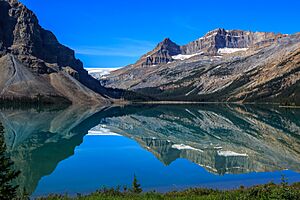Mount Thompson (Alberta) facts for kids
Quick facts for kids Mount Thompson |
|
|---|---|

Mount Thompson seen from Icefields Parkway at Bow Lake. Portal Peak to left.
|
|
| Highest point | |
| Elevation | 3,089 m (10,135 ft) |
| Prominence | 369 m (1,211 ft) |
| Parent peak | Mount Baker (3180 m) |
| Listing | Mountains of Alberta |
| Geography | |
| Location | Alberta, Canada |
| Parent range | Waputik Mountains Canadian Rockies |
| Topo map | NTS 82N10 |
| Geology | |
| Age of rock | Cambrian |
| Type of rock | Sedimentary |
| Climbing | |
| First ascent | 1898 by J. Norman Collie, Hugh Stutfield, H. Woolley |
| Easiest route | Scrambling Southwest slope |
Mount Thompson is a mountain summit located in Banff National Park, Alberta, Canada. It stands about four kilometers west of Bow Lake. This peak is part of the Canadian Rockies and the Waputik Mountains.
Mount Thompson is 3,089 meters (10,135 feet) tall. Its closest higher peak is Mount Baker, which is about 5 kilometers (3.1 miles) to the west. You can easily see Mount Thompson from the Icefields Parkway near Bow Lake.
Contents
The Story of Mount Thompson
Mount Thompson is named after Charles Sproull Thompson (1869-1921). He was an explorer who made many first climbs in the Canadian Rockies.
How the Mountain Got Its Name
In August 1897, Charles Thompson, Hugh Stutfield, and J. Norman Collie camped by Bow Lake. They then climbed the Bow Glacier, which was much larger back then. After that, they crossed the Wapta Icefield to reach the top of Mount Gordon.
From Mount Gordon, they saw many mountains that didn't have names yet. They decided to name one of them Mount Thompson, after Charles. The mountain's name became official in 1928.
First Climbers to the Top
The very first time someone climbed to the top of Mount Thompson was in 1898. This climb was made by Norman Collie, Hugh Stutfield, and Herman Woolley.
Charles Thompson also named Portal Peak. This smaller peak is about 1.5 kilometers (0.9 miles) southeast of Mount Thompson. Portal Peak is next to Bow Glacier, which in 1897 was seen as the main entrance to the Wapta Icefield.
How Mount Thompson Was Formed
Mount Thompson is a mountain that was formed by strong pushing forces in the Earth. It sits between the Bow Glacier and Peyto Glacier.
The Rocks of the Mountain
Like other mountains in Banff Park, Mount Thompson is made of sedimentary rock. This type of rock forms from layers of sand, mud, and tiny bits of sea creatures. These layers were laid down over millions of years, from the Precambrian to the Jurassic periods.
Mountain Building
During a time called the Laramide orogeny, huge forces pushed these sedimentary rock layers. They were pushed east and even slid over younger rock. This process slowly built up the tall mountains we see today.
Weather Around Mount Thompson
Mount Thompson is in a subarctic climate zone. This means it has very cold and snowy winters. The summers are usually mild.
Temperatures and Water
In winter, temperatures can drop below -20 °C (-4 °F). With the wind, it can feel even colder, sometimes below -30 °C (-22 °F). The snow and ice that melt from Mount Thompson flow into the Bow River. The Bow River is a branch of the Saskatchewan River.




